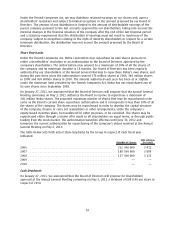Nokia 2010 Annual Report Download - page 20
Download and view the complete annual report
Please find page 20 of the 2010 Nokia annual report below. You can navigate through the pages in the report by either clicking on the pages listed below, or by using the keyword search tool below to find specific information within the annual report.capabilities. The implementation of our new strategy is expected to have a significant impact on our
personnel, including substantial reductions in personnel following the appropriate consultations. This
may cause disruption and dissatisfaction among employees, as well as fatigue due to the cumulative
effect of several other reorganizations in the past few years. As a result, employee motivation, energy,
focus and productivity may be reduced causing inefficiencies and other problems across the
organization and leading to the loss of key personnel and the related costs in dealing with such
matters. Moreover, our employees may be targeted aggressively by our competitors during the
implementation of our new strategy, and some employees may be more receptive to such offers,
leading to the loss of key personnel. Accordingly, we may need to adjust our compensation and
benefits policies and take other measures to attract, retain and motivate skilled personnel aligned
with the changes to our mode of working and culture needed to implement our new strategy
successfully. This will require significant time, attention and resources of our senior management and
others within the organization and may result in increased costs. We have encountered, and may
encounter in the future, shortages of appropriately skilled personnel, which may hamper our ability to
implement our strategies and materially harm our business and results of operations.
We face intense competition in the mobile products and digital map data and related
locationbased content markets.
We experience intense competition in every aspect of our business and across all markets for our
mobile products. Mobile device markets are increasingly segmented, diversified and commoditized.
We face competition from a growing number of participants in different user segments, price points
and geographical markets, as well as layers of the mobile product using different competitive means
in each of them. In some of those layers, we may have more limited experience and scale than our
competitors. This makes it more difficult and less costefficient for us to compete successfully with
differentiated offerings across the whole mobile device market against more specialized competitors.
It also limits our ability to leverage effectively our scale and other traditional strengths, such as our
brand, manufacturing and logistics, distribution, strategic sourcing, R&D and intellectual property, to
achieve significant advantages compared to our competitors.
In the smartphone market, we face intense competition from traditional mobile device manufacturers
and companies in related industries, such as Internetbased product and service providers, mobile
operators, business device and solution providers and consumer electronics manufacturers. Some of
those competitors are currently viewed as more attractive partners for application developers, content
providers and other key industry participants, resulting in more robust global ecosystems and more
appealing smartphones; have more experience, skills, speed of product development and execution,
including software development, and scale in certain segments of the smartphone market; have a
stronger market presence and brand recognition for their smartphones; have created different
business models to tap into significant new sources of revenues, such as advertising and
subscriptions; or generally have been able to adjust their business models and operations in an
effective and timely manner to the developing smartphone and related ecosystem market
requirements.
The availability and success of Google’s free open source Android platform has made entry and
expansion in the smartphone market easier for a number of hardware manufacturers which have
chosen to join Android’s ecosystem, especially at the midtolow range of the smartphone market.
Product differentiation is more challenging, however, potentially leading to increased
commoditization of Androidbased devices with the resulting downward pressure on pricing. On the
other hand, the significant momentum and market share gains of the global ecosystems around
Apple’s iOS proprietary platform and the Android platform have increased the competitive barriers to
additional entrants looking to build a competing global smartphone ecosystem, like Nokia using the
Windows Phone platform. At the same time, other ecosystems are being built which are attracting
developers and consumers, such as Research in Motion’s efforts around Blackberry Messenger, and
may result in fragmentation among ecosystem participants and the inability of new ecosystems to
gain sufficient competitive scale. During the transition of our smartphones to the Windows Phone
19
























